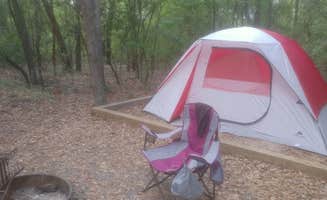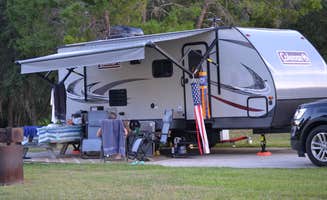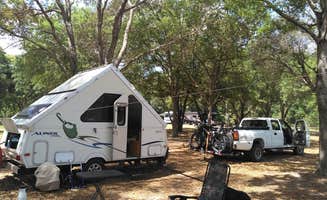Primitive camping options define the landscape near Middleburg, Florida, with multiple state forests offering backcountry campsites accessible by hiking trails. Water features are central to the camping experience, with Black Creek and numerous lakes providing opportunities for water recreation throughout the region. While some sites require permits or reservations, many state forest camping locations operate on a first-come, first-served basis with minimal amenities.
What to do
Hiking through forest ecosystems: Jennings State Forest contains approximately 23,000 acres and 30 miles of trails through diverse terrain. "There are many well marked trails that run through the site as well as a fishing area and grills near the parking lot," notes one visitor. Some trails include stream crossings and connect to various primitive campsites.
Kayaking and paddling: Black Creek Ravine offers opportunities to explore waterways from a riverside campsite. "It is about 30 feet through some trees to the river, so if you were clever, I'm sure you could find it from a boat, but for us there was zero competition for the single campsite," reports a camper who hiked in. The 2.4-mile hike to reach this site rewards paddlers with direct river access.
Swimming and water recreation: Mike Roess Gold Head Branch State Park features lake swimming areas and equipment rentals. "Canoes for rental available in Park," mentions one reviewer. The park's spring-fed lakes provide year-round swimming opportunities, though water levels can fluctuate seasonally.
What campers like
Natural privacy between sites: Jennings State Forest Hammock Campground receives praise for its layout. "With 16 campsite each being semi private you will love the sounds of the wind in the trees and hawks flying over. Each has tent pad, in ground grill and picnic table," explains a camper. This privacy comes from strategic vegetation placement rather than large site spacing.
Quiet wilderness settings: Campers appreciate the solitude available at primitive sites. "First time here and I will have to say, what a nice place. It's cheap. Seems like no one is around and a few of the spots are closed for the Covid-19 but will have to say. Even though I only spend 1 night and it poured all night, I would do it again," shared one visitor about Jennings State Forest.
Wildlife viewing opportunities: The forests around Middleburg provide habitat for diverse wildlife. "You can see the stars through the hardwoods, and on the hike in you can see deer, squirrels, and all kinds of different birds," noted a camper at Black Creek Ravine. Early mornings offer the best wildlife viewing chances, particularly near water sources.
What you should know
Limited cell service: Forest settings often have spotty connectivity. "Cell service gets spotty but if you're here to have your nose in your phone, you are missing out," reports a Jennings State Forest camper. Coverage tends to improve at developed campgrounds and worsen in ravines and dense forest areas.
Ticks and insects can be prevalent: Insect protection is essential, especially during warmer months. "Many white spotted ticks," warns one camper about Jennings State Forest. Long pants, closed shoes, and insect repellent are recommended for hiking to primitive sites.
Navigation can be challenging: Camp Chowenwaw Park and other locations may require preparation. "It was a good 10 minute hike with our gear to get to the tree houses from parking area near pool. Wagons are provided but pack light to save the trouble," advises a camper. Detailed maps are available at ranger stations for most locations.
Access to water sources varies: Water availability should be considered when planning trips. "You have water access from the river as long as you have a purification system, but you're on your own for bathrooms, electricity, etc., what you can carry in is what you have," notes a Black Creek Ravine visitor. Bring sufficient water or appropriate purification systems for primitive sites.
Tips for camping with families
Consider tree house accommodations: Camp Chowenwaw Park offers unique sleeping quarters. "Each screened in non electric Treehouse slept 4 in bunk beds. There were several central fire rings with a picnic table/benches throughout the unit. A shared bathhouse with toilets, sinks, lights, and hot showers was available in the unit also," describes one family. These elevated accommodations appeal particularly to children.
Look for campgrounds with playground access: Some locations feature facilities specifically for younger campers. "We could hang our hammocks and the paved roads allowed for the kids to ride their bikes. It was peaceful and we would go again!" shares a family that camped at Camp Blanding.
Choose sites with swimming options: During warm months, water access becomes important. "The children loved the close proximity of the lake. We were approximately 10 feet away from the water. The area had two sets of swings nearby and a dock," mentions a Camp Blanding visitor. Swimming areas with designated boundaries offer safer recreation for children.
Tips from RVers
Reserve specific sites for larger rigs: Starke-Gainesville NE KOA offers varying site sizes and configurations. "Our rig is 42' w/ 4 slides and had lots of space. Escorted to our site. Nice picnic tables," notes one RVer. Sites on Walnut, Chestnut, Magnolia, and Spruce typically accommodate larger vehicles more comfortably.
Consider seasonal campground differences: Summer heat impacts RV camping comfort. "No shade but a huge amount of space between sites and set up on an angle which increased the sense of space. Sites had full hook up, elec, water, sewer," reports an RV camper at Starke KOA. Sites with afternoon shade become premium during summer months.
Expect variable site conditions: Ground stability can change with weather. "The water pressure at the sites was great, pool was very pretty, space was great between sites - not on top of each other," shares another KOA visitor. Some campgrounds provide materials like sawdust for wet conditions during rainy periods.













